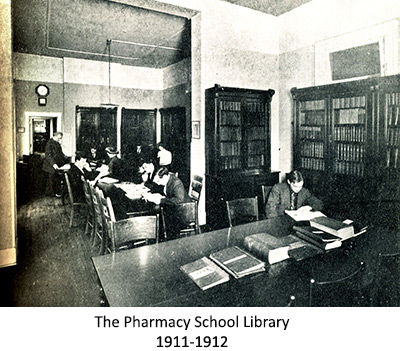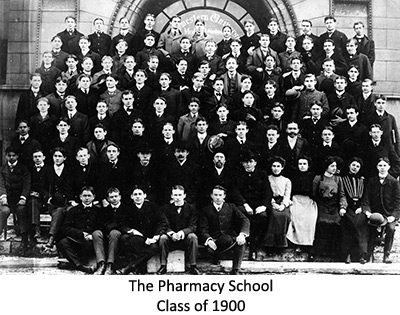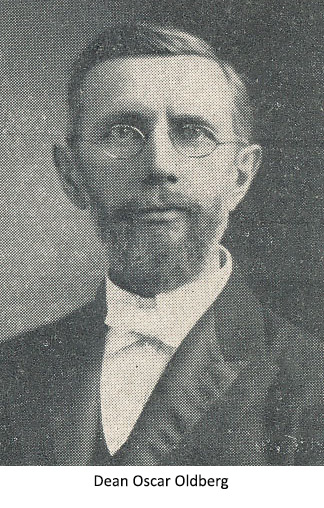(This article is part of an occasional series prepared by Galter librarians on the history of and highlights about various Northwestern University health education programs and their alumni. Earlier articles were about Northwestern University's medical, woman's medical, dental, and nursing schools.)
By: Ramune K. Kubilius, Galter Library interim Special Collections Librarian
The School of Pharmacy of Northwestern University opened its doors Oct. 1, 1886, was placed under the complete control of the University in 1891, changed facilities, underwent a number of curricular transitions, and graduated many students, until combining into the program at University of Illinois in June 1917. Though the duration of the program at Northwestern University was relatively brief, interest in the School of Pharmacy as a part of Northwestern University’s history remains to this day.
Early years
 The official initiative favoring the establishment of a school of pharmacy in connection with Northwestern University was taken by the executive committee of the board of trustees at its regular meeting in April 1886. A resolution was then adopted. This action was taken upon the motion of Dr. David R. Dyche, a member of the board of trustees of the University and of its executive committee, and a pharmacist in active business in Chicago. Conferences were held with other prominent pharmacists and with men of experience in pharmaceutical educational work. The result was the incorporation of a school called Illinois College of Pharmacy and at the annual meeting of the board of trustees in June, the school thus incorporated was, by agreement with the incorporators, formally adopted as a department of Northwestern University. The school opened its doors Oct. 1, 1886 in quarters formerly occupied by the Library of the City of Chicago in the Dickey Building on the southwest corner of Lake and Dearborn Streets, where it remained for five years. The building had a lecture room seating two hundred, and four laboratories which together provided accommodations for two hundred and forty students working simultaneously. From 1893-1902, the school shared a building with the medical school on Dearborn Street, between 24th and 25th Street, and later was housed in the university’s “Professional Schools Building”, across the street from the original site in the Dickey Building.
The official initiative favoring the establishment of a school of pharmacy in connection with Northwestern University was taken by the executive committee of the board of trustees at its regular meeting in April 1886. A resolution was then adopted. This action was taken upon the motion of Dr. David R. Dyche, a member of the board of trustees of the University and of its executive committee, and a pharmacist in active business in Chicago. Conferences were held with other prominent pharmacists and with men of experience in pharmaceutical educational work. The result was the incorporation of a school called Illinois College of Pharmacy and at the annual meeting of the board of trustees in June, the school thus incorporated was, by agreement with the incorporators, formally adopted as a department of Northwestern University. The school opened its doors Oct. 1, 1886 in quarters formerly occupied by the Library of the City of Chicago in the Dickey Building on the southwest corner of Lake and Dearborn Streets, where it remained for five years. The building had a lecture room seating two hundred, and four laboratories which together provided accommodations for two hundred and forty students working simultaneously. From 1893-1902, the school shared a building with the medical school on Dearborn Street, between 24th and 25th Street, and later was housed in the university’s “Professional Schools Building”, across the street from the original site in the Dickey Building.
Initially, the courses of instruction at Northwestern University’s school, election of its teachers, all educational requirements, and the conferring of degrees were placed under the direct supervision of the board of trustees and the president of the University. Administration of the school was entrusted to the special board of trustees of the School of Pharmacy, the members of which voluntarily assumed the task of providing for its adequate equipment and financial support until it should be securely established. In 1891 the University assumed complete control of the management of the School, retaining the members of its special board of trustees as an advisory executive committee and the school name became the School of Pharmacy of Northwestern University.
School enrollment and curriculum highlights
Attendance at the School of Pharmacy increased from 62 in 1886-87 to 316 by 1892. In 1893, attendance decreased when the school was moved from the center of the city to 24th and Dearborn Streets. In 1899, requirements for admission and graduation were made more rigorous. The course of instruction was lengthened to two annual school sessions of twenty-six weeks each, and annual attendance in 1899-1900 fell to 138. A 1901 ad in the Quarterly Bulletin of Northwestern University Medical School proudly announced: “It is the largest institution of its kind west of the Atlantic coast states.” (Q Bull Northwest Univ Med Sch. 1901 Jun; 3(1): 179.)
 The 1910/1911 catalog highlighted that the school offered a scientific training in Pharmacy, Chemistry, and Drug and Food Analysis. There were also special courses for Drug Clerks. The 1911/1912 catalog mentioned that the value of the equipment used exclusively for the students of pharmacy was over $25,000 or “five times the amount required of the Registered Schools of Pharmacy” under the laws of New York. The two established college courses in pharmacy in the United States at that time were for the degree of Graduate in Pharmacy (Ph.G.) and the degree of Pharmaceutical Chemist (Ph.C.). At Northwestern, both courses were arranged so all work for the degree of Ph.G. could be completed in two years of six months each, and for the degree of Ph.C. in two years of nine months each, “provided the students do not divide their time between drug store employment and their college work, as is done by more than one-half of the students of pharmacy in this country.” The museum contained more than 2000 specimens of drugs, chemicals, pharmaceutical preparations, chemical and pharmaceutical apparatus and implements. The library possessed “one of the most valuable pharmaceutical reference libraries in this country” and contained all of the pharmacopoeias of the world with supplements to date. Fees and expenses were listed: a registration fee ($10), annual tuition fees ($100), breakage deposit ($10), a laboratory coupon ticket ($5), and a graduation fee ($10). The catalog also claimed that “[t]he physical, social and moral welfare of the students receive careful attention. The advantage of association with students of all the other schools of the University is great. The magnificent gymnasium building and the great athletic field bring many intercollegiate games to Northwestern and give the students opportunities to participate in and to witness the events under the most favorable conditions.”
The 1910/1911 catalog highlighted that the school offered a scientific training in Pharmacy, Chemistry, and Drug and Food Analysis. There were also special courses for Drug Clerks. The 1911/1912 catalog mentioned that the value of the equipment used exclusively for the students of pharmacy was over $25,000 or “five times the amount required of the Registered Schools of Pharmacy” under the laws of New York. The two established college courses in pharmacy in the United States at that time were for the degree of Graduate in Pharmacy (Ph.G.) and the degree of Pharmaceutical Chemist (Ph.C.). At Northwestern, both courses were arranged so all work for the degree of Ph.G. could be completed in two years of six months each, and for the degree of Ph.C. in two years of nine months each, “provided the students do not divide their time between drug store employment and their college work, as is done by more than one-half of the students of pharmacy in this country.” The museum contained more than 2000 specimens of drugs, chemicals, pharmaceutical preparations, chemical and pharmaceutical apparatus and implements. The library possessed “one of the most valuable pharmaceutical reference libraries in this country” and contained all of the pharmacopoeias of the world with supplements to date. Fees and expenses were listed: a registration fee ($10), annual tuition fees ($100), breakage deposit ($10), a laboratory coupon ticket ($5), and a graduation fee ($10). The catalog also claimed that “[t]he physical, social and moral welfare of the students receive careful attention. The advantage of association with students of all the other schools of the University is great. The magnificent gymnasium building and the great athletic field bring many intercollegiate games to Northwestern and give the students opportunities to participate in and to witness the events under the most favorable conditions.”
In 1904-1905, School of Pharmacy entrance required completion of at least one year of high school. In 1909, the staff consisted of ten teachers and assistants, the classes in attendance came from all parts of the country, and alumni numbered 1,700. In 1912-1913, the course for the Degree of Graduate in Pharmacy was lengthened from three eighteen-week terms to two full scholastic years and the course for the Degree of Pharmaceutical Chemist was extended from two to three scholastic years. At the same time, the President’s Report indicated that the minimum admission requirement was advanced from one year of high school work to the completion of a four year high school course. By 1916-17, however, enrollment had dwindled to fifty-nine. The trustees decided that the university could no longer maintain the school. An arrangement was made to transfer the students and goodwill of the School of Pharmacy of Northwestern University to the School of Pharmacy of the University of Illinois. Since the school of pharmacy conducted in Chicago by the University of Illinois was offering an equivalent program, it was decided that “the two schools could be combined without loss of efficiency and without increased cost to either.” This was done in June 1917.
 During its years of operation, the School of Pharmacy of Northwestern graduated over 2000 students. It evolved and went through various curricular changes. Through the years, the school placed the education of pharmacists on a professional footing. Changes in entrance requirements were made, sometimes initiated by the university and sometimes following pharmacy education trends. Pharmacists today earn a PharmD degree. On its current web page devoted to “Pre-Pharmacy”, Northwestern University’s Academic Advising Center highlights educational requirements for today’s students who are planning to pursue a pharmacy degree: six to eight years (two to four years undergraduate education plus four years professional education at a college of pharmacy), as opposed to the early programs' (such as Northwestern's) requirements that applicants complete at least one year of high school prior to the two (later three) year programs. The majority of present programs accept students after three or more years of college and the completion of college course prerequisites; some pharmacy schools require or give preference to applicants with a bachelors (B.S./B.A.) degree.
During its years of operation, the School of Pharmacy of Northwestern graduated over 2000 students. It evolved and went through various curricular changes. Through the years, the school placed the education of pharmacists on a professional footing. Changes in entrance requirements were made, sometimes initiated by the university and sometimes following pharmacy education trends. Pharmacists today earn a PharmD degree. On its current web page devoted to “Pre-Pharmacy”, Northwestern University’s Academic Advising Center highlights educational requirements for today’s students who are planning to pursue a pharmacy degree: six to eight years (two to four years undergraduate education plus four years professional education at a college of pharmacy), as opposed to the early programs' (such as Northwestern's) requirements that applicants complete at least one year of high school prior to the two (later three) year programs. The majority of present programs accept students after three or more years of college and the completion of college course prerequisites; some pharmacy schools require or give preference to applicants with a bachelors (B.S./B.A.) degree.
Deans and alumni
 School of Pharmacy Dean Oscar Oldberg was educated in Europe and taught at other U.S. pharmacy schools before being associated with Northwestern University for over 25 years. He was on leave for two academic years due to ill health during which time Arthur Herbert Wilde served as Acting Dean. When Oscar Oldberg retired and became Dean Emeritus, Pharmacy School alumnus Charles Waggener Patterson (Ph.C.) served as Acting Dean for the 1912-1913 academic year. John Harper Long served as Dean from 1913 until 1917 when the school consolidated with University of Illinois. The papers of Oscar Oldberg can be found in University Archives, Evanston campus. This finding aid includes a biography that highlights his considerable professional achievements. Arthur Herbert Wilde was a historian and administrator as well as author of a 1905 university history used as a source for this historical synopsis. John Harper Long was a chemistry professor, who was associated with the university for thirty-seven years (he also taught in the medical school), and was a co-author of a chemistry textbook with Prof. Oldberg.
School of Pharmacy Dean Oscar Oldberg was educated in Europe and taught at other U.S. pharmacy schools before being associated with Northwestern University for over 25 years. He was on leave for two academic years due to ill health during which time Arthur Herbert Wilde served as Acting Dean. When Oscar Oldberg retired and became Dean Emeritus, Pharmacy School alumnus Charles Waggener Patterson (Ph.C.) served as Acting Dean for the 1912-1913 academic year. John Harper Long served as Dean from 1913 until 1917 when the school consolidated with University of Illinois. The papers of Oscar Oldberg can be found in University Archives, Evanston campus. This finding aid includes a biography that highlights his considerable professional achievements. Arthur Herbert Wilde was a historian and administrator as well as author of a 1905 university history used as a source for this historical synopsis. John Harper Long was a chemistry professor, who was associated with the university for thirty-seven years (he also taught in the medical school), and was a co-author of a chemistry textbook with Prof. Oldberg.
After graduation, many alumni continued their professional lives in the pharmaceutical field. They went on to work in and founded drug stores as well as drug and other manufacturing companies, and they patented inventions. But it was not necessarily expected that all would remain in the field. One school recruitment effort was notated as an annotation to a laboratory building photograph in the 1911/1912 catalog: "Many Pharmacy students find their training a large part of the preparation necessary for a Medical course." Indeed, alumni changed their fields after graduation from the school and some continued their ties with the university. Here are two examples:
The aforementioned Charles Waggener Patterson was not only an alumnus of the School of Pharmacy, but he also stayed to work at the university in various capacities until his retirement in 1940, decades after the school was closed. A news item about his retirement appeared in the Quarterly Bulletin of the Medical School (1940 Winter; 14(4): 315): “Charles Waggener Patterson retired from the service of the University at the close of the last school year. Born in Chicago in 1870, Mr. Patterson served the University since his graduation from the School of Pharmacy, Northwestern University in 1892. Since that time he has been Assistant Professor of Chemistry, Dean of the School of Pharmacy, and Registrar of the Medical School, having been in the latter post since 1912.”
Another alumnus of the Pharmacy School, Dr. Herman L. Kretschmer (1879-1951), graduated from the school with a Ph.G. in 1900, then went on to graduate with high honors from Northwestern’s medical school in 1904, and was awarded an honorary DSc in 1944. He did post-graduate studies in Europe, served in World War I, and upon his return, remained in Chicago for the rest of his life. He was credited with being one of the first clinical professors to limit his work to urology. He taught at Rush Medical College, was a clinician at Children’s Memorial Hospital, and worked at other area hospitals. A prolific author of about 300 documents, he was a contributor to textbooks and also served as an elected and honorary officer of many local and national organizations, including the 1944-1945 term as president of the American Medical Association. A Galter Health Sciences Library website article in 2014 described Dr. Kretschmer’s accomplishments and highlighted a library display that featured his student notebooks from his days as both a pharmacy and medical student that had been donated to the library. (Members of Dr. Kretschmer's extended family visited Galter Library's Special Collections in November 2015 to celebrate his legacy and accomplishments.)
Galter Library's Special Collections contains historical items comprising books, photographs, instruments, and equipment that are available for study and viewing. Please email Special Collections for an appointment.
Sources
Northwestern University 1855 A History 1905, Arthur Herbert Wilde, New York: University Publishing Society, 1905.
Northwestern University: A History 1850-1975, Harold F. Williamson and Payson S. Wild, Evanston, IL: Northwestern University, c. 1976.
Northwestern University: celebrating 150 years / Jay Pridmore. 1st ed. Evanston, IL: Northwestern University Press, 2000.
Northwestern University: A History, Jay Pridmore, Evanston, IL: Northwestern University, c.2012. Updated and expanded edition of Northwestern University: celebrating 150 years / Jay Pridmore. 1st ed. Evanston, IL: Northwestern University Press, 2000.
Northwestern University Bulletin, General Catalogue of the School of Pharmacy [misc. years].
Updated: January 13, 2022